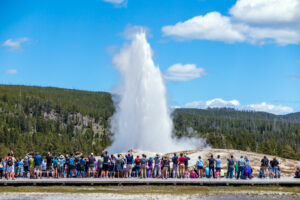The Most Underrated Power Source: Geothermal Energy

In the second 2020 presidential debate, which took place last week, President Donald Trump chastised Joe Biden for wanting to “get rid of the oil industry.”
The day after the debate, Biden clarified his comments and said that he would not get rid of the oil industry or fracking.
But I’m sure his comments still gave oil industry workers pause.
Regardless of what happens to the oil industry in the years to come, there’s an easy way to keep those drillers and others in the exploration and production (E&P) companies employed.
You see, Biden would still need well drillers. They just wouldn’t be drilling for oil and gas.
This 24/7 Energy Source Is as Green as They Come
Geothermal energy is often referred to as the “also-ran renewable energy source.”
When talking about renewable energy, writers and analysts (yours truly included) often ignore or forget about geothermal.
But it’s time we start paying attention.
Geothermal is the ideal renewable energy source. It’s nonpolluting, it’s available all the time, and new technology will greatly expand its use.
This renewable power has had many technological advancements in the last several decades. Now it’s ready to become a mainstream source of clean energy.
And here’s the best part: The drilling, fracking and well-completion skill sets that all of those struggling oil and gas E&P companies have are needed by the geothermal industry.
How Does It Work?
Trapping this reliable, always-on energy source is a little tricky.
Geothermal heat comes from the Earth’s core about 4,000 miles straight down. There, temperatures are as hot as the sun’s surface. I’m talking more than 10,800 degrees Fahrenheit.
The simplest form of a geothermal energy system is the geothermal heat pump. This system extracts energy found just under the Earth’s surface. Water is circulated through a grid of pipes and extracts heat energy from the ground.
That heat is then transferred to the inside of a home or other building.
Conventional geothermal systems can be used only in areas where the resource is relatively close to the surface.
Reykjavík, Iceland, and Boise, Idaho, both tap underground reservoirs of geothermal hot water.
The hot water and steam are piped to the surface and used to directly heat buildings. In addition, superheated water (above 212 degrees Fahrenheit) under pressure is brought to the surface where it flashes to steam.
This high-pressure steam is used to spin a turbine generator that produces electricity.
Once the water is cooled, it is returned to the aquafer it came from. This is done via pumps connected to injection wells.
In many places, geothermal heat breaks the surface or comes close to it. The Old Faithful geyser in Yellowstone National Park is the most famous example.
Commercial geothermal power plants have been around in the U.S. since the first one opened at The Geysers, California, in 1960. Today, there are more than 60 in operation around the country.
In some areas of the world (like the ones mentioned above), the hot water and steam resource is located just below impermeable rock layers, making it easy to tap. In the U.S., most geothermal power generation takes place in seven western states, as well as Hawaii and Alaska.
One of the benefits of geothermal power generation is that it’s always available. That makes it the only renewable energy resource that provides baseload power.
What’s in It for Investors?
Today, investors have few choices when it comes to investing in geothermal energy. In fact, you can count them all on one hand.
However, that could be about to change. That’s because enhanced geothermal systems (EGS) don’t need a superheated reservoir to operate.
Remember, the deeper we go toward the center of the Earth, the hotter it gets. Drilling into these heated layers of rock, fracking them and circulating water through them is the essence of an EGS.
The directional drilling and fracking technology needed here is exactly the same as what is used today in the pursuit of unconventional oil and gas. As this technology evolves, I expect to see oil and gas E&P companies transition to EGS drilling companies.
In another year or so, there will be many more investment choices in geothermal energy than there are today. I’ll continue to monitor these exciting advances.
Good investing,
Dave






